Size-Inclusive Pattern Designers Muna and Broad: The Full Interview

Leila Kelleher and Jess Rodda are the founders of the independent pattern line Muna and Broad (MunaAndBroad.com). They met on Instagram, where they shared an interest in stylish sewing. As plus-size sewers, they agreed that the home-sewing industry wasn’t serving an important part of the market. Driven by their own wishes for well-fitting patterns, Leila and Jess decided to give the sewing community a solution. They realized that, between them, they had all the skills needed to create and market a line of patterns drafted for bust sizes up to 64 inches, and hips to 71-1/2 inches—beyond the range of major commercial pattern brands and most independent pattern companies.
So they set up their own company to focus on versatile and modern pieces, which can be mixed, matched, and interpreted by the maker as casual or dressy. These wardrobe-building, easy-to-sew patterns have garnered many fans among people with limited options for buying or making stylish clothing. These enthusiasts are inspired and supported by the creative community of makers Leila and Jess have built.
A long-distance relationship
Despite their close collaboration, Jess and Leila have never met in person. Jess is based in New Zealand and Leila, Australian by birth, resides in Canada. They communicate across time zones and have established a division of labor that plays to their strengths. Leila is a trained patternmaker with a doctorate in biomechanics; this combination helps her draft patterns that correctly fit bodies larger than “straight” sizes. Jess has a background in marketing, website construction, and social media, and she has an established blog on plus-size sewing. That means she is suited to running the online part of the business. Jess tests the patterns and is involved in proofing instructions, which are written and illustrated by Leila.
Threads asked Leila and Jess about their pattern line, their design philosophy, and their thoughts on sewing for plus-size people. A shorter version of this interview appeared in Threads #216, Winter 2021. Here, you can learn even more about how they run the company and Muna and Broad’s commitment to serving the plus-size community.
Threads: Please share how and why you started your pattern company.
Jess (on behalf of Muna and Broad): Muna and Broad started after Leila got in touch and asked me if I wanted to collaborate and release a free pants pattern that she’d drafted for herself, with a full-seat and a full-tummy adjustment built in. I tried the pattern, and loved them and so I set up an email newsletter so that folks could get access to the free Glebe Pants. We released them in three sizes initially, with our size (54-inch to 57-inch hip) as the smallest size.
We realized pretty quickly that, while folks were getting a great fit, the really minimal instructions were proving difficult for less experienced sewists, and we couldn’t expect that folks would be super experienced with sewing since our size range was hitting folks who may not have been included by other pattern companies. We decided that we could expand the sizing and put together some more thorough instructions, and so Muna and Broad was born.
Many of our patterns are the “firsts” for makers. Our Waikerie Shirt might be their first shirt-making experience, our pants patterns are often the first pants folks have ever made.
Although we met online and started our friendship through Instagram, we’re both Australian and found that we have quite a bit in common (including a love of cooking, natural fibers, etc. etc.) so if we weren’t in business together, we’d probably be great Instagram buddies.
Muna is a pet name for Leila, and Broad comes from Broad In The Seams, my blog.
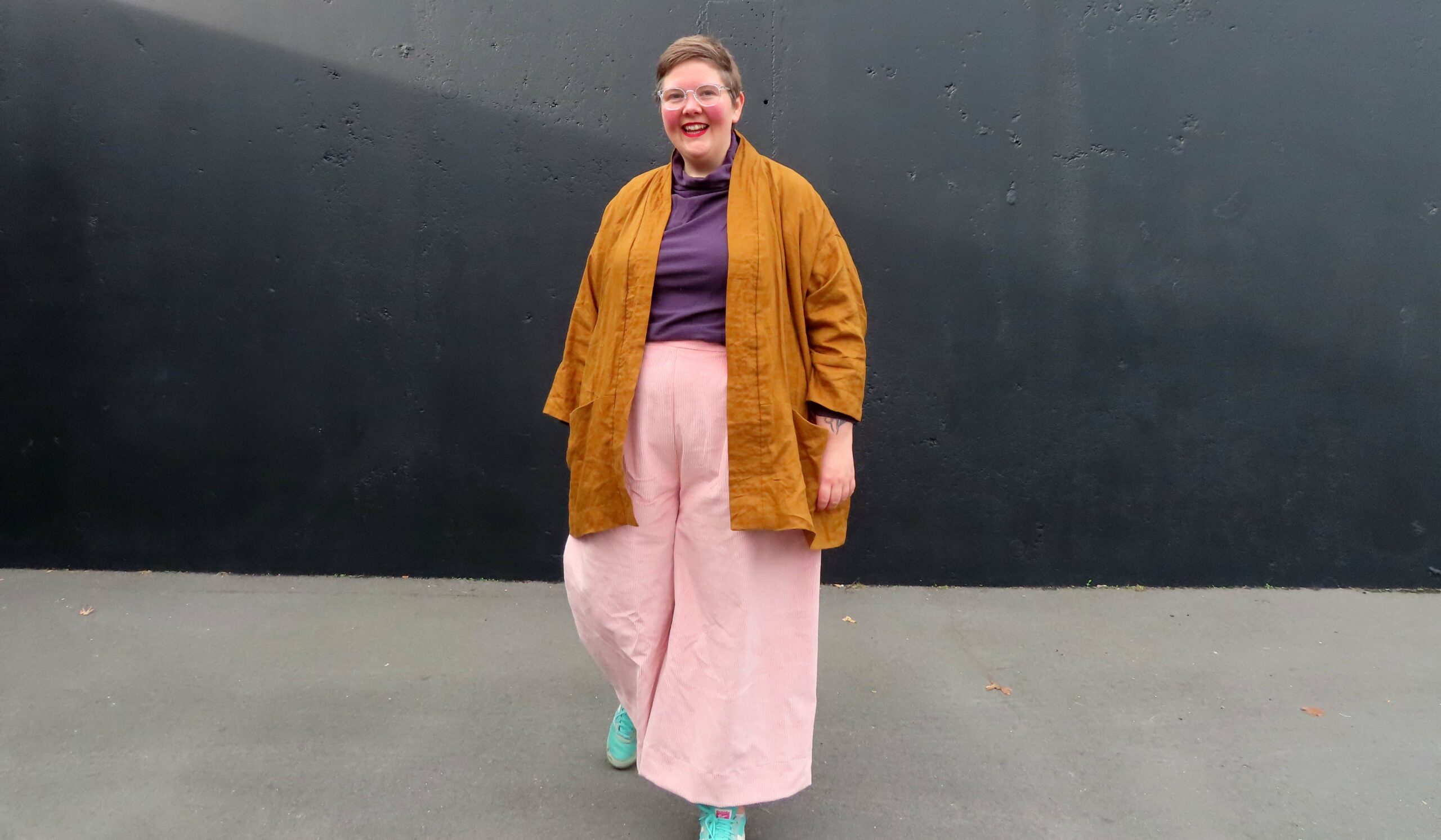
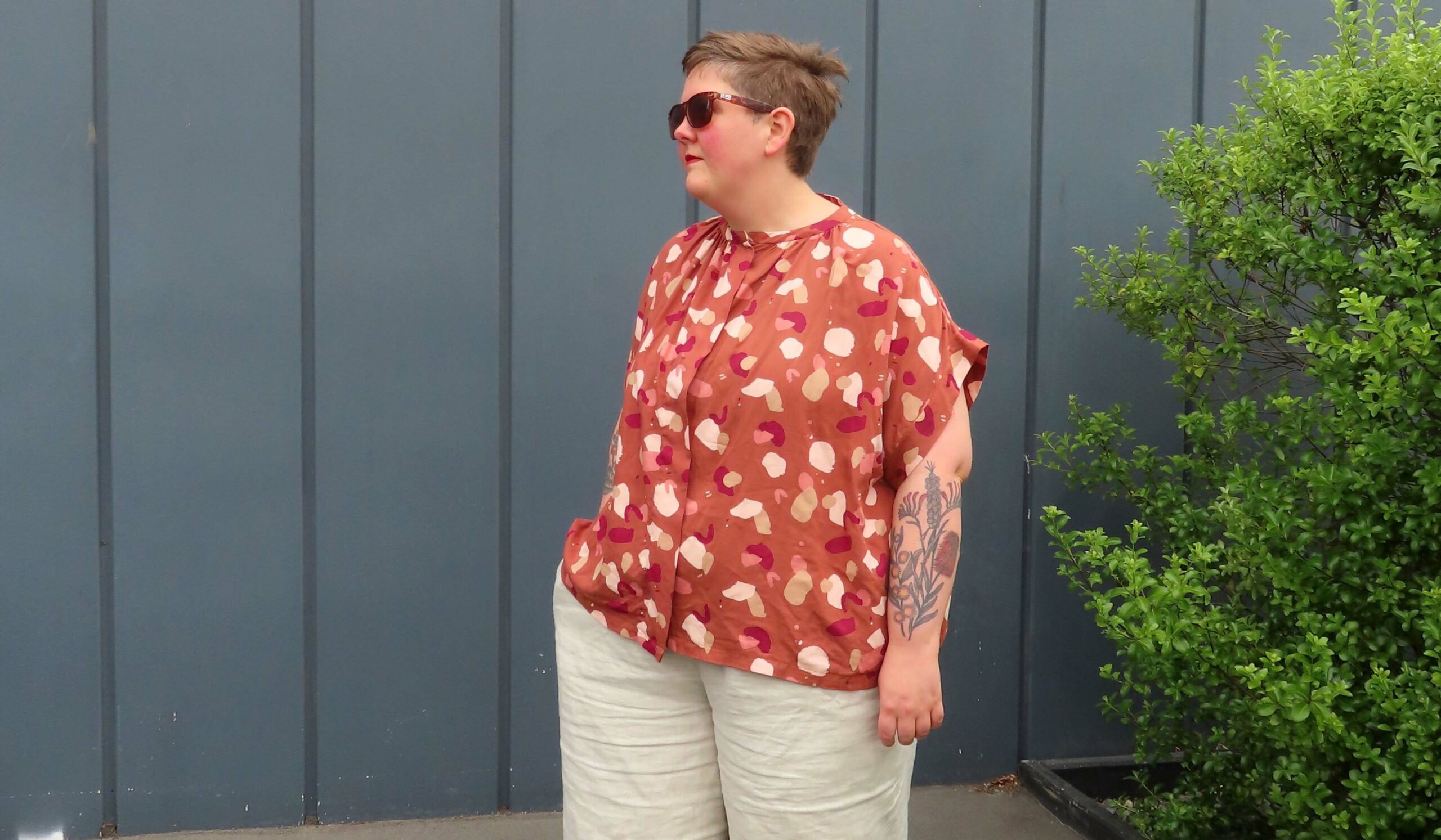
TH: Who is your target audience, and how did you discover them?
MB: We started releasing patterns together because there were patterns for things that we wanted, which weren’t available in our size, and we knew from being involved in the plus-size sewing community on Instagram that there were things that folks wanted but which didn’t come in their size.
We both had a style of clothes that we wanted which wasn’t being catered for. A lot of what came close to our size were garments which were “traditionally flattering” (highlighting the waist, flaring out over the hips, etc.) and ultrafeminine. Our patterns are architectural, they’re relaxed, they’re modern and perfect for natural fibers. Basically, I suppose we were our target audience, but we presumed that others would be there with us.
We have free sew-along videos for many of our patterns on YouTube, and we’ve got quite a few patterns which would be perfect for absolute beginners—folks who’ve never sewn before. But we also have some more ambitious projects with lovely finishes for folks to sink their teeth into.
In August 2020, we started a Patreon account, and this has blossomed into a great community. We do monthly pattern bonuses for our Insider and Maker level supporters, share weekly podcast-style chats, sewing tips, and behind-the-scenes news. We also set up a forum for our Patreons and this year we started hosting monthly Zoom Sewing Circle meetups where Patreons can join us to sew and chat (or sew and listen to chat happening) through Zoom. This little community of makers, who live all across the world, has given us incredible insight into the variety of folks who are making our patterns, and it’s been an amazing chance to get to know folks better, too!
TH: What are your backgrounds pre-Muna and Broad, and how do your other skills and experience help in creating the patterns and running the company?
MB: Leila studied fashion production at college (the technical side of fashion—patternmaking, grading, and garment construction) and has worked in film, theater, as a seamstress for a couture studio, and as a freelancer. Now she has a Ph.D in biomechanics and works as a professor in Canada. Leila combines her fashion production knowledge with her knowledge of the body through her work in biomechanics by patternmaking for bodies like ours.
I’ve had a varied background, but my work has mostly been in marketing and data (customer-relations management systems) in the arts. I started sewing in mid-2017, something I’d wanted to try for quite a few years, and soon after set up a “sewing only” account on Instagram. I then started a sewing blog, where I shared free plus-size sewing patterns I’d found online and also blogged about some of my own makes. My nerdy teenage years building websites, and early adoption of social media, have come in handy for M&B. I set up our website, take care of social media and emails from makers, and I run the day-to-day stuff on our Patreon. I’m also involved in the proofing and original testing of the instructions, which ends up being quite a collaborative process.
TH: What challenges did you encounter en route to getting the business up and running?
MB: One of the biggest challenges for us is the time difference. We’ve never met in person, and we chat mostly through Instagram messages. Sometimes, we’ll Facetime each other. There’s a really limited sliver of time each day where we’re both awake, and it’s worse during the northern hemisphere’s summer because of daylight savings. Now, we’ve been working together for almost two years and we have systems in place. These include a lot of shared folders and Excel spreadsheets and weekly catch-ups before we record our video chat for Patreons.
We agree that being in business together is a great outcome, and wouldn’t want to go it alone. We get to work to our strengths in the day-to-day work that we do for M&B, but we also have a built-in sounding board for any decisions. Working together has allowed us to work probably more than twice as fast as we might have otherwise. Our website launched in November 2019, and as of August 2021 we’ve released 23 patterns! Thanks to the support of Patreon, it was possible for me [Jess] to quit my full-time job in mid-2020. Now Muna and Broad is my primary source of income, which is pretty amazing.
TH: What is the size range represented in your patterns, and how did you come up with that range?
MB: Our current size range, Sizes A to M, covers 40-inch to 64-inch bust and 41.5-inch to 71.5-inch hip. We also offer a free grading service when our size chart is too small to include someone.
Our current largest size is based on the largest tester we could find when we expanded from just three sizes, purely because we wanted to be able to test the sizes that we were releasing. Because the largest size was set by this testing requirement, we’ll also grade our patterns up for free for anyone who is above our current size range. We offer this because we know that folks who are above our current size range have very few options in both ready-to-wear clothing and sewing patterns.
The lower end of our size range was set by demand from the community. After every expansion, we still had folks getting in touch to say, “I’d love to make your patterns but I’m smaller than your current size range.” So we kept expanding down. Not all of our patterns are available in our latest size range (the Size A to M range) yet, but we are working through the back-catalog as we’re able to find the time.
TH: How do you decide what designs to make?
MG: Our patterns are released as a collection, of sorts, with each pattern working with patterns that have come before. Part of this is because we wanted to make sure that folks could make complete outfits and fill their wardrobes with our patterns. Since our size range was serving a lot of folks who didn’t have other options, we didn’t feel like we could assume that folks would necessarily have things in their wardrobe to pair with any pattern we might release.
We’ve amassed a great collection of patterns that are beginner-friendly, including pants, tops, a T-shirt, and undies. Any of these would make a great first project for a new maker. But, we’ve also added some more complicated projects like a quilted coat, and a “shacket” [shirt-jacket], which brings in some of the juicy aspects of making a coat.
We definitely do like to concentrate on patterns, which are straightforward to fit and sew, and we build quite a few common adjustments into our patterns. We’ve released quite a few pants patterns with built-in full-tummy and full-bum adjustments because we felt like sewing a great-fitting pair of pants was quite a struggle. We also made quite a few cup-size flexible top patterns, like our bust-dart-free Torrens Box Top and Waikerie Shirt. This removes that fitting challenge, which can pop up quite early on for plus-size makers.
We have also released the Tarawi Shirt, which is a fairly classic, relaxed-fit button-down with four cup sizes (including a no-bust option for those with non-reconstructive mastectomies or gender nonconforming folks who bind their chest or have had top surgery) and two biceps width options. We created this shirt to be a real wardrobe workhorse.
TH: Can you share how you grade for all the sizes in the range? How does this differ from the way standard pattern companies draft up their size range?
MB: We’ve tried to be as inclusive as possible by thinking about how bodies change throughout the size range, so we’re not simply grading up and down from our sample size, but actually making tweaks and changes to the grade rules every couple of sizes so that we’re including and properly fitting typical bodies at that particular size.
This means we avoid those classic problems that often come with grading up to larger sizes, because we know that arms don’t keep getting longer, and shoulders don’t keep getting broader as you go up through the size range. Essentially, this way of grading “re-blocks” every few sizes and it’s a method Leila came up with by studying and assessing the different “typical” bodies at each of the sizes through our range.
Leila studied grading at college, but this style of grading is quite intuitive and comes from a lot of time looking at different bodies to assess where the changes happen as they move through the size range. A lot of the analytical skill came from her experience as a biomechanist—being able to analyze the biomechanics of a body regardless of size. Our ultimate aim is to have patterns that remove those pain-points in plus-size sewing. We want to built in the full-biceps adjustment, and build in full-tummy adjustments so that the pattern will fit the majority of makers straight from the pack.
TH: Who writes and illustrates your instructions?
MB: Leila writes and illustrates our instructions, and I do the proofing and test the instructions out to make sure they’re very clear and easy-to-understand. Our patterns, even the ones that are relatively simple, always include some great techniques or nice finishes you can sink your teeth into. This means that even experienced makers might be sewing things up in a way that’s totally new to them, so it’s important that the instructions and illustrations are very explicit, and not open to interpretation or confusion.
Leila also records sew-along videos for our patterns, which we make available for free on our YouTube channel. Some of the sew-along videos cover the entire garment, and some just show the trickier sections of each make. We get quite a bit of positive feedback from folks about this.
TH: How do you test your patterns?
MB: We’ve tested our patterns using different methods but our current model is a paid testing model. We feel really strongly that our business shouldn’t be built on the free labor of other makers, so we cover the cost of materials (fabric, thread, etc.), printing the pattern in large format/A0 at a copy shop, and we pay for time toward the sewing of the garment.
Pattern testers aren’t also required to take part in unpaid marketing of the patterns as part of the testing, we only ask for fit photos for our internal use.
Basically, we want the testing to be as stress-free as possible. We want to make sure that folks are compensated for their time and expertise, but also that they’re able to give unbiased feedback and not be worried about being asked back if they don’t share their photos widely enough.
TH: What are your favorite patterns from Muna and Broad?
MB: The pattern that we both get the most wear out of is still our Glebe Pants, which is such a great silhouette. Leila’s favorite pattern, and the one that she’s most proud of, is our Shoalhaven Shacket. The shacket is a cross between a shirt and a jacket and it’s a great project, which has some really satisfying finishes. Probably my favorite pattern of ours is the Waikerie Shirt. I think it’s because I basically started sewing because I couldn’t find relaxed linen shirts in my size range. So, the Waikerie Shirt—and the expanded sewing dress versions—is a pattern where we fulfilled my wardrobe dreams (and which are quite straightforward projects).
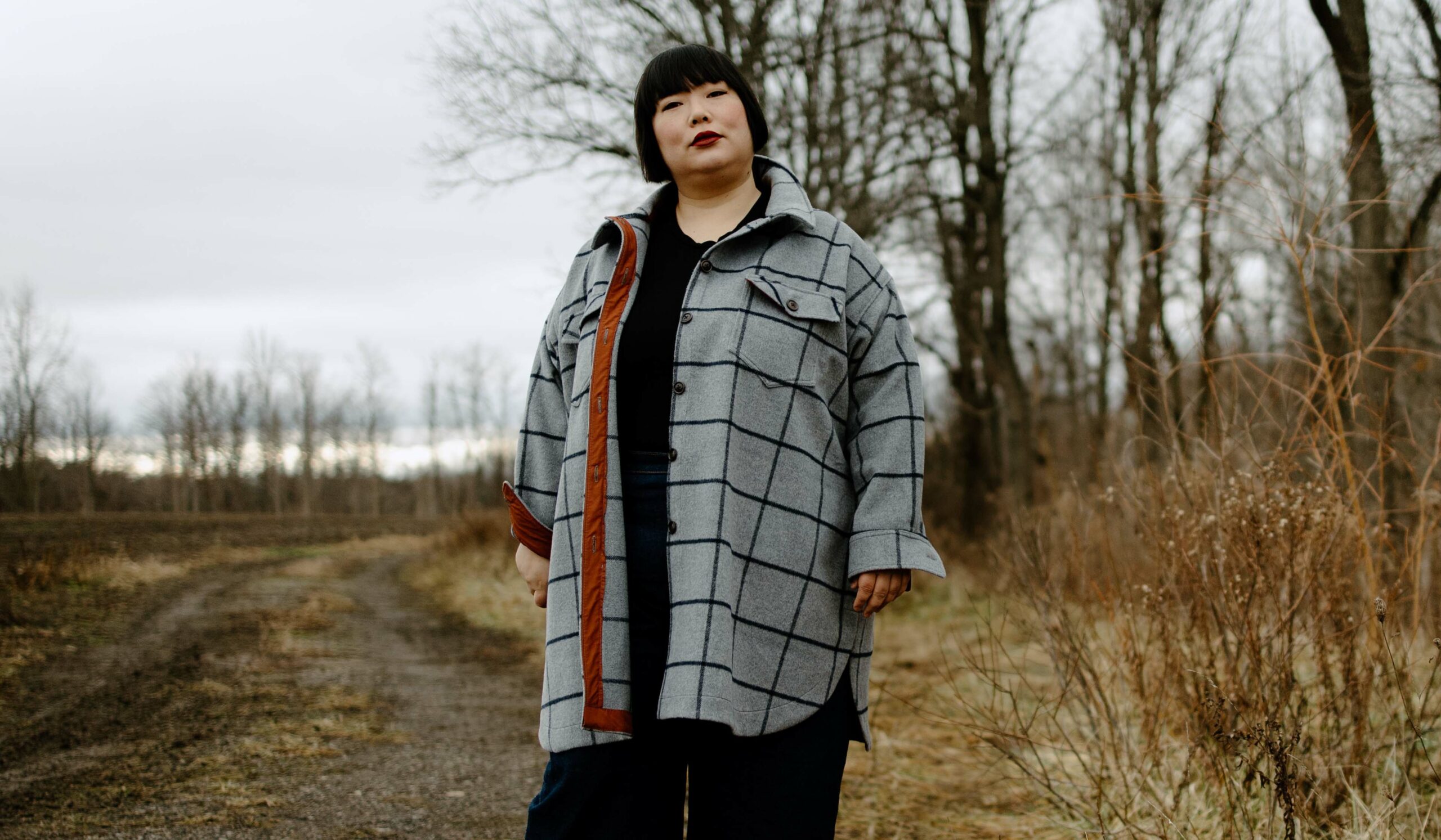
TH: How has social media influenced your work in pattern design and sales? Has it helped you craft a particular brand identity?
MB: We met through social media, and still haven’t met in real life—so most of our interactions still happen online through social media. I think because we were both quite involved with plus-size sewing Instagram before we started working together, we had an idea of patterns that were missing, styles that were missing and what consumers cared about (since we were also consumers who felt like things were missing).
TH: What advice would you give to a plus-sized person who is just starting out in sewing?
MB: I think our best advice is to start with a pattern that is designed for your size and that will not require any major adjustments, such as a full-bust adjustment or full-bum adjustment. We don’t think it’s reasonable to ask a new sewist to acquire more advanced skills (adjustments, complex fitting, grading up to their size). That way the new sewer is more likely to get a successful result and keep on sewing. If possible, seek out an online or in-person sewing class that teaches patterns in your size. Ask the sewing school to offer a plus-size alternative if you aren’t in the size range of the patterns being taught. Having someone guide you through sewing your first garments is a huge help in gaining the confidence to work from patterns independently.
There’s a lot of pressure when you’re engaged in the online sewing community. The big one that we’ve both noticed is the pressure for folks to be constantly improving their sewing, or to show that they’re progressing through some kind of imagined stages, eventually ending with couture finishes. That path is totally right for some folks but we feel that it’s important all levels of sewing are honored.
If you want to sew and wear knit T-shirts and comfortable elastic-waist pants, then do that. If you want to make a few boxy tops in linen but never progress to tailoring a jacket, that’s also perfectly fine. There’s really not one way to be a sewist and there’s no path that must be followed for you to be doing it right.
Also, you really don’t need much in the way of equipment. It can be easy to be misled into thinking that you need all kinds of gadgets, or high-end sewing machines (or a particularly prized vintage machine), but the reality is that you can make great clothes with very little equipment. Leila, despite having worked professionally as a sewer, is fairly minimalist in her equipment.
TH: How difficult or expensive would it be for an independent pattern company to expand its size range to include more bodies on the larger end of the spectrum? Is drafting/grading know-how the biggest obstacle?
MB: The biggest obstacle for pattern companies expanding their sizing to include plus-sizes is to deal with their own misconceptions about larger bodies. Much the same as with ready-to-wear clothing, ideas persist that plus-size folks aren’t spending money on patterns or clothes because they’re waiting for their bodies to be smaller, or they simply don’t spend money on these things. We know firsthand that this just is not the case and, in fact, many plus-size sewers need to sew garments in order to fill their wardrobe. So they might spend more money on patterns than folks who have the option to easily buy ready-to-wear clothing.
We have heard people say that drafting for plus sizes is more difficult and large bodies are more diverse in shape. However, we do not subscribe to these beliefs. A good patternmaker should be able to make a pattern to fit any body since it is essentially the same skill set (creating a two-dimensional pattern to become a three-dimensional garment). I think what people really could say instead is that they are inexperienced working with larger bodies and, therefore, there can be some time and trial and error to adapt the eye to the different pattern shapes that a large body might require. Taking the time to consider what the typical body looks like at various measurements also requires that you look at large bodies.
The cost of expanding the size range can depend on different factors. It might be necessary to develop a plus-size block. If so, then this does take time. However, plus-size sewers are out there with money ready to buy the patterns. So it’s definitely not wasted time. In fact, it’s probably more financially prudent to spend time working on a size expansion (that will sell more patterns) than pattern hacks (which increase the utility of existing patterns but don’t necessarily generate more sales).
Photos: courtesy of Muna and Broad.




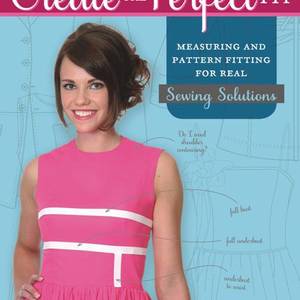

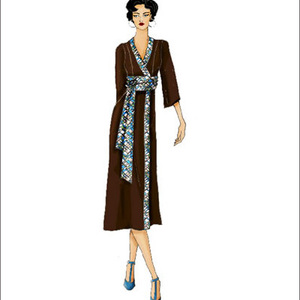

























Log in or create an account to post a comment.
Sign up Log in